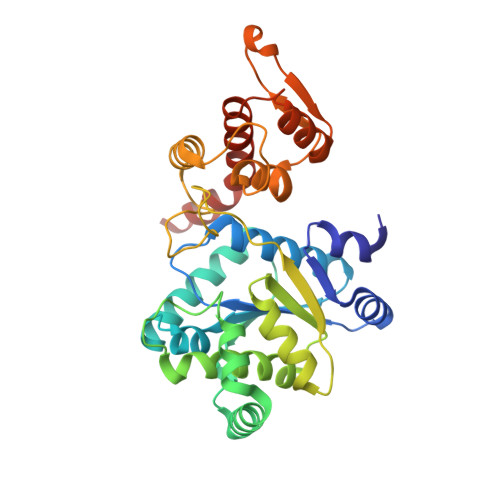Overcoming Near-Cognate Suppression in a Release Factor 1-Deficient Host with an Improved Nitro-Tyrosine tRNA Synthetase.
Beyer, J.N., Hosseinzadeh, P., Gottfried-Lee, I., Van Fossen, E.M., Zhu, P., Bednar, R.M., Karplus, P.A., Mehl, R.A., Cooley, R.B.(2020) J Mol Biol 432: 4690-4704
- PubMed: 32569745
- DOI: https://doi.org/10.1016/j.jmb.2020.06.014
- Primary Citation of Related Structures:
6WRK, 6WRN, 6WRQ, 6WRT - PubMed Abstract:
Genetic code expansion (GCE) technologies incorporate non-canonical amino acids (ncAAs) into proteins at amber stop codons. To avoid unwanted truncated protein and improve ncAA-protein yields, genomically recoded strains of Escherichia coli lacking Release Factor 1 (RF1) are becoming increasingly popular expression hosts for GCE applications. In the absence of RF1, however, endogenous near-cognate amber suppressing tRNAs can lead to contaminating protein forms with natural amino acids in place of the ncAA. Here, we show that a second-generation amino-acyl tRNA synthetase (aaRS)/tRNA CUA pair for site-specific incorporation of 3-nitro-tyrosine could not outcompete near-cognate suppression in an RF1-deficient expression host and therefore could not produce homogenously nitrated protein. To resolve this, we used Rosetta to target positions in the nitroTyr aaRS active site for improved substrate binding, and then constructed of a small library of variants to subject to standard selection protocols. The top selected variant had an ~2-fold greater efficiency, and remarkably, this relatively small improvement enabled homogeneous incorporation of nitroTyr in an RF1-deficient expression host and thus eliminates truncation issues associated with typical RF1-containing expression hosts. Structural and biochemical data suggest the aaRS efficiency improvement is based on higher affinity substrate binding. Taken together, the modest improvement in aaRS efficiency provides a large practical impact and expands our ability to study the role protein nitration plays in disease development through producing homogenous, truncation-free nitroTyr-containing protein. This work establishes Rosetta-guided design and incremental aaRS improvement as a viable and accessible path to improve GCE systems challenged by truncation and/or near-cognate suppression issues.
Organizational Affiliation:
Oregon State University, Department of Biochemistry and Biophysics, 2011 Agricultural and Life Sciences, Corvallis, OR 97331, USA.

















